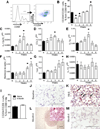A critical role for macrophages in promotion of urethane-induced lung carcinogenesis
- PMID: 22048774
- PMCID: PMC3221921
- DOI: 10.4049/jimmunol.1100558
A critical role for macrophages in promotion of urethane-induced lung carcinogenesis
Abstract
Macrophages have established roles in tumor growth and metastasis, but information about their role in lung tumor promotion is limited. To assess the role of macrophages in lung tumorigenesis, we developed a method of minimally invasive, long-term macrophage depletion by repetitive intratracheal instillation of liposomal clodronate. Compared with controls treated with repetitive doses of PBS-containing liposomes, long-term macrophage depletion resulted in a marked reduction in tumor number and size at 4 mo after a single i.p. injection of the carcinogen urethane. After urethane treatment, lung macrophages developed increased M1 macrophage marker expression during the first 2-3 wk, followed by increased M2 marker expression by week 6. Using a strategy to reduce alveolar macrophages during tumor initiation and early promotion stages (weeks 1-2) or during late promotion and progression stages (weeks 4-16), we found significantly fewer and smaller lung tumors in both groups compared with controls. Late-stage macrophage depletion reduced VEGF expression and impaired vascular growth in tumors. In contrast, early-stage depletion of alveolar macrophages impaired urethane-induced NF-κB activation in the lungs and reduced the development of premalignant atypical adenomatous hyperplasia lesions at 6 wk after urethane injection. Together, these studies elucidate an important role for macrophages in lung tumor promotion and indicate that these cells have distinct roles during different stages of lung carcinogenesis.
Figures






References
Publication types
MeSH terms
Substances
Grants and funding
LinkOut - more resources
Full Text Sources
Other Literature Sources
Medical

